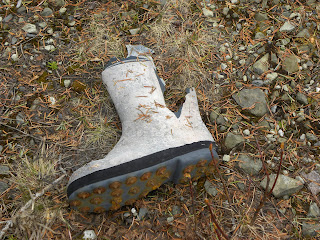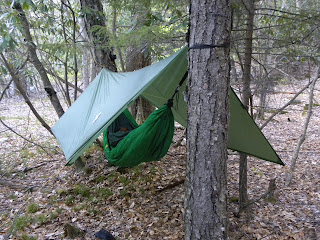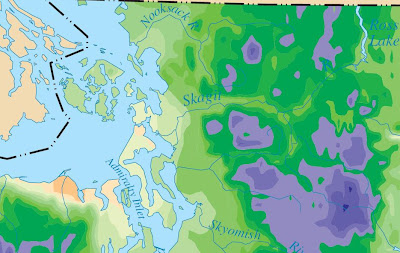 This winter we've been hiking up gated logging roads on Washington state Dept of Natural resources and private timber company land. Timberland
open to public travel in the Pacific Northwest is often owned and
managed by private timber companies and state government. In Oregon, state timberland is managed by the Oregon Department of Forestry. Private timber companies around here in northwest Washington are usually Sierra Pacific and Longview Timberlands. On weekdays, you have to keep an eye open for log trucks, heavy equipment and speeding trucks if there are crews working in the area.
This winter we've been hiking up gated logging roads on Washington state Dept of Natural resources and private timber company land. Timberland
open to public travel in the Pacific Northwest is often owned and
managed by private timber companies and state government. In Oregon, state timberland is managed by the Oregon Department of Forestry. Private timber companies around here in northwest Washington are usually Sierra Pacific and Longview Timberlands. On weekdays, you have to keep an eye open for log trucks, heavy equipment and speeding trucks if there are crews working in the area.This type of hiking is definitely not wilderness hiking; expectations must be reset and these forests places in context. These lands are officially designated for wood production and managed by professional foresters. State and private "working forests" are not supposed to be natural areas or wilderness preserves just like farms, pastures, subdivisions, cities and your backyard and garden are not. However, timberlands are much more natural and quiet than farms and rural areas and many "wildlands" in more developed parts of the US that many people perceive as pleasant, idyllic, aesthetically-pleasing landscapes worthy of appreciation and preservation.

Tree farm trekking is a good option when snow at higher elevations in the mountains is bad due to ice, crust or high avalanche danger. Tree farm trekking is a also good option when tides are not right timing for saltwater sea kayaking or rivers too high for safe canoeing from recent heavy rains or snowmelt. Do NOT go tree farm trekking in summer when high elevation trails in scenic subalpine zones are snow-free.
Most people prefer trails in natural settings and would avoid hiking on logging roads passing through clearcuts. While I don't prefer timberland hikes I do admit there are positives.
- Dogs can run off leash and it's unlikely we'll see other people and disturb them.
- There are almost no trails not buried by snow in winter and much of spring in the Northwest. A lot of outdoor recreation in the Pacific Northwest involves traveling on, and dealing with, some form of water be it river, lake, saltwater or snow. There are no options for snow-free, mountain, wilderness hiking from about mid-October until July in the Pacific Northwest. The mountain wilds of the Pacific Northwest are different than the mountain wilds of the central and southern Appalachians or the Southwest. Gated logging roads may be the only snow-free hiking option in some areas and it's much better than staying home. Many people hike the same low elevations trails over and over, year after year. Examples, would be the Chuckanuts and Angels Rest in the Columbia Gorge. Eventually, I'd rather explore new areas even if the route is a gated or seldom-driven forest road.

- Logged-off landscapes are not devoid of plants and wildlife. There is Nature to be seen on tree farm treks. It is open space and somewhat natural Wildlife like black bears, deer, porcupines, grouse, elk, hawks, eagles, frogs, salamanders, many songbirds. Common forest wildflowers in spring. Land use regulations require riparian buffers along creeks.
 |
| avalanche lillies in early May |
 |
| Western trillium |
Below is an excerpt from Trees Are the Answer by Patrick Moore.
- A lot of people think logging road hikes are boring and not worth walking. In my experience, it's not worth pushing a mountain bike up to coast and speed back down. Sometimes I'll push the bike. It depends on the road. Some logging roads are pretty steep. Bikes are best for rolling terrain.


- It's usually quiet, there's fresh air, and it's exercise. Logging roads can be steep and gain a lot of elevation so can be used as training hikes for real mountain hikes in summer. Motor vehicles like dirt bikes and 4-wheeler/quad/ATVs are not usually not allowed on most private timber company land. Sometimes OHV riders illegally ride around gates, down and over trenched berms and on old skid roads. Gates are good because they block pickup trucks and Jeeps which in turn cuts down on unsafe target shooting, trash dumping and mudding.

 |
| snow at 4400' in early June North Cascades |
 |
| old rubber caulk ("cork") boot |
- History Channel's Ax Men shows why and how loggers do what they do.
- A much more critical book of logging in the Northwest is Wintergreen: Rambles in a Ravaged Land by Robert Michael Pyle
- The Footsore series by Harvey Manning has suggestions of hikes and explorations in western Washington timberlands, farms, cities and rural areas. Harvey Manning accepts this type of hiking and recommends not being a "wilderness snob" (in Footsore 4). Footsore books were scouted in the late 1970s and early 1980s so some of the suggested areas have been posted No Trespassing and/or closed to the public by residential development.
- Craig Romano's write up for Bald Hills is a good example of an article of tree farm trekking
Hiking up gated logging roads in the Pacific Northwest can be a lot more wild than hiking on trails and "wilderness" in other parts of the USA. And, it's better than not hiking, biking or exploring at all.





















